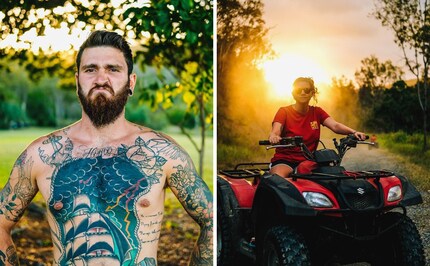

No Zoom, No Problem
Leave your zoom lens at home, all you need is a fixed focal length lens. In this article, you'll find out why I've been preferring to shoot with fixed focal length lenses for some years now, and how this can also be useful for your photography.
A little over a year ago, when I was packing my backpack, I had no trouble choosing which t-shirt and shorts to take on my trip. It was only when my gaze turned to my camera lenses that I had mixed feelings. Unfortunately, taking all the lenses with me was not an option. For one thing, I wasn't strong enough (I'm still not) and for another, I didn't have the financial means to hire a sherpa for several months.
So I opted for a mix of zoom and fixed focal length lenses. In the meantime, the 50mm lens has carved out a special place in my camera bag and I find it hard to part with it. Looking back, it's the photos taken with a fixed focal length lens that I enjoy the most. Why is that? Let me now highlight some of the advantages of fixed focal length lenses.
What are fixed focal length lenses?
Before I get started, I'd like to briefly touch on the theory. What exactly are fixed focal length lenses?
They're camera lenses (mirrorless or SLR) that have a fixed wide angle and therefore can't zoom. Most have a higher luminosity. They can therefore capture more light at once which allows for shorter exposure times.
Once bokeh, always bokeh!
The bokeh argument is, in my opinion, one of the most important. So important that a whole section could be dedicated to it! In fact, we could even write a whole article about it (coming soon)... In simple terms, bokeh is the part of a photo that lies outside the focus zone and is therefore blurred. Depending on brightness and the optical treatment of the lens, bokeh is either beautiful to look at or looks like a nervous jumble.

Naturally, there are zoom lenses with excellent bokeh. However, these are often in the same price range as a small car (second-hand from 2002). On the other hand, with most manufacturers, it is possible to acquire an excellent lens by investing between CHF 100 and CHF 300.
The ability to deliberately place parts of the photo outside the focus area with a beautiful bokeh, offers a whole new level of design to many amateur photographers. A level that gives the viewer a professional impression.

Image quality
A zoom lens requires a lot of glass arranged in different ways and the whole thing also needs to be able to move back and forth. The design of a fixed focal length lens, on the other hand, is much simpler. As is often the case, less is more in this case, and the 'more' translates into much better image quality. I could also mention vignetting, chromatic aberration and distortion, but I don't feel like it right now. There are plenty of comparisons on the Internet. Try it yourself and then you'll only reluctantly screw a zoom lens onto your camera body.

More light for your sensor
With aperture values below f/2.8. fixed focal length lenses tend to be brighter! Brighter means shorter shutter times and therefore a lower risk of blurring effects due to camera movement or the subject being photographed. Isn't that great? Especially when photographing indoors and in low light, the extra brightness of your lens can make all the difference!
After a while, you'll know your millimetres
If you often shoot with a particular fixed focal length, your eyes get used to the wide-angle of your lens. This allows you to photograph more consciously and you'll then find it easier to recognise patterns and highlight them correctly. It will be as if your eyes are able to see a glimpse of the detail in the photo.

Aerobic clicking and photographic yoga session
Without zoom, there's no need for a fitness membership! Want to get closer to your motif? Then you need to get moving! This not only keeps you fit, but also stimulates your creativity.
However, training is primarily about your flexibility and stamina. This is because fixed focal length lenses are generally smaller and lighter than zoom lenses!(great, another advantage!)
However, in certain situations it's better to use a long zoom lens. For example, for a close-up of a grizzly bear or a lion. Unless you own one of those 600mm fixed focal length wide-angle lenses. In an emergency, you can absolutely use this huge lens for self-defence purposes.

How many millimetres do you want
18- or 23-millimetre wide-angle for landscape shots? 35- or 50-millimetre for street shots? 85- or 100-millimetre for portraits? Or do you prefer a sporty 300 millimetre?
Fixed focal length lenses come in many models. The ideal model for you depends on the motifs you prefer to photograph. If you're about to buy your first fixed focal length lens, I recommend a lens between 23 millimetres and 50 millimetres (full format). These wide-angle lenses are versatile and the angle of view should be familiar to you because of its similarity to your kit lens. What's more, most manufacturers in this field offer a well-priced but quality lens.

Are you already a big fan of fixed focal length lenses? Tell me about your experiences in the comments field. Together, we'll help needy "zoomers" make the right choice!
My lenses:

Other quality lenses:
More from Denny Phan at www.35waves.com/
You may also be interested in these articles:
A camera in one hand, an airline ticket in the other. That's what I call a perfect situation.
Find out more about me and my photography on <a href="https://www.instagram.com/35waves/" target="_blank">Instagram</a> or on my <a href="https://www.35waves.com/" target="_blank">website</a>
From the latest iPhone to the return of 80s fashion. The editorial team will help you make sense of it all.
Show all




